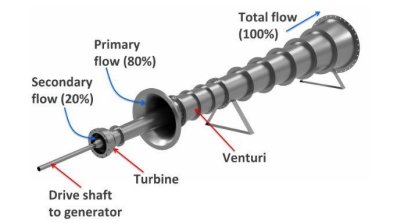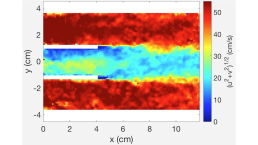Improving the Efficiency of Low-Head Hydropower

- Researcher: Graham Benham
- Academic Supervisors: Ian Hewitt and Colin Please
- Industrial Supervisor: Paul Bird
Background
Generation of electricity from elevated water sources has been the subject of much scientific research over the last century. Typically, in order to produce cost-effective energy, hydropower stations require large flow rates of water across large pressure drops. The pursuit of low head hydropower is largely avoided because turbines which deal with large flow rates are very expensive. Thus, regions of relatively flat land, such as large parts of the UK, miss out on hydropower due to the lack of sufficient elevated water sources.  VerdErg has invented a device called VETT (Venturi Enhanced Turbine Technology) which can produce cost-effective low head hydropower by exploiting the venturi effect. It does so by allowing the majority of the flow to bypass the turbine, whilst converging to a faster, low pressure stream, thereby ‘sucking’ the rest of the flow through the turbine which experiences a much larger pressure drop. In this way the turbine remains relatively cheap because it deals with the minority of the flow, whilst a high power is maintained via the amplified pressure drop. Other advantages include the low environmental impact on aquatic life, since the majority of the flow avoids the turbine, passing through a section with no moving parts.
VerdErg has invented a device called VETT (Venturi Enhanced Turbine Technology) which can produce cost-effective low head hydropower by exploiting the venturi effect. It does so by allowing the majority of the flow to bypass the turbine, whilst converging to a faster, low pressure stream, thereby ‘sucking’ the rest of the flow through the turbine which experiences a much larger pressure drop. In this way the turbine remains relatively cheap because it deals with the minority of the flow, whilst a high power is maintained via the amplified pressure drop. Other advantages include the low environmental impact on aquatic life, since the majority of the flow avoids the turbine, passing through a section with no moving parts.
The efficiency of VETT depends upon the mixing of the fast and slow flows in a closed channel. In particular, the shape of the channel has an effect on how the flows mix and therefore the resulting amount of power generated. The aim of this project is to model and optimise the mixing of the flows, with a view to improve VETT efficiency.
Outcomes
 We created a mathematical model for the mixing of flows in a channel which shows good agreement with both experiments (velocity data shown to the right) and computational fluid dynamics [1]. Using this model, we optimised the shape of the channel to promote mixing. Both numerical and analytical optimisation techniques were used to find optimal channel shapes [2]. We found that, whilst swirl increases shear layer growth rates, it also increases pressure losses [3], indicating no efficiency improvements from added swirl.
We created a mathematical model for the mixing of flows in a channel which shows good agreement with both experiments (velocity data shown to the right) and computational fluid dynamics [1]. Using this model, we optimised the shape of the channel to promote mixing. Both numerical and analytical optimisation techniques were used to find optimal channel shapes [2]. We found that, whilst swirl increases shear layer growth rates, it also increases pressure losses [3], indicating no efficiency improvements from added swirl.
Publications
[1] Benham, G.P., Castrejon-Pita, A.A., Hewitt, I.J., Please, C.P., Style, R.W. and Bird, P. Turbulent shear layers in confining channels. Journal of Turbulence 19:6 (2018), pp. 431-445.
[2] Benham, G.P., Hewitt, I.J., Please, C.P. and Bird, P. Optimal control of diffuser shapes for confined turbulent shear flows. arXiv preprint arXiv:1710.07950 (2017).
[3] Benham, G.P., Hewitt, I.J., Please, C.P. and Bird, P. The effect of swirl on confined co-axial flow. arXiv preprint arXiv:1805.02961 (2018).

